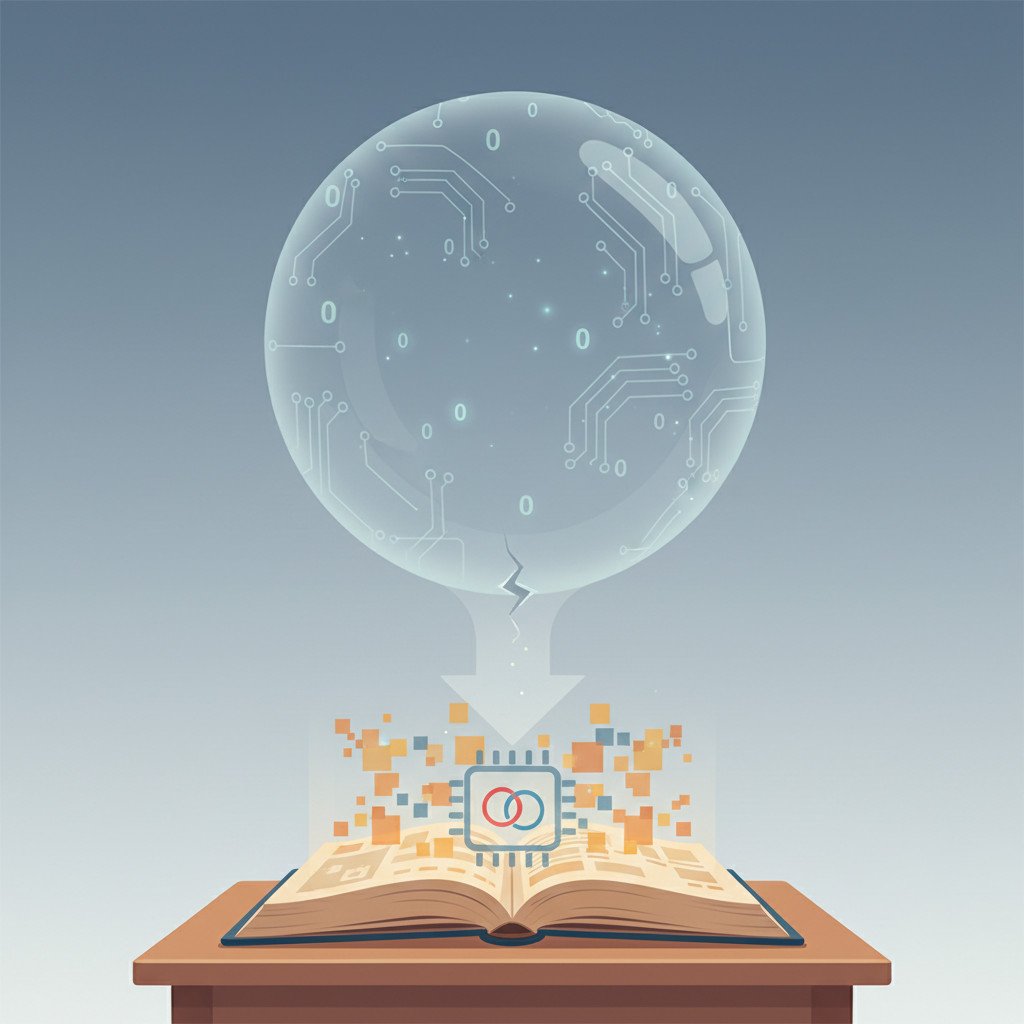AI bubble debate and AI textbook programme failure in Korea: Market reality check and education fallout
AI bubble debate and AI textbook programme failure in Korea force a hard rewind. Because investors chased growth and education systems rushed adoption, both hype and policy went unmoored. However the fallout is tangible, from halved school uptake to sunk costs and frayed trust.
This piece digs into market signals and policy mistakes. First we examine whether AI stock valuations mirror dot com excess. Then we pivot to South Korea’s costly experiment with AI textbooks and public backlash. Finally we weigh lessons for regulators educators and investors to temper hype and shape safer adoption.
Moreover the debate matters beyond markets and classrooms. As a result policymakers must balance innovation with rigor and oversight. Ultimately this introduction sets a cautious, evidence driven tone for the analysis ahead. Read on to judge for yourself. Stay skeptical and curious.

AI bubble debate and AI textbook programme failure in Korea
What does an AI bubble mean in practice? In short, it describes prices and expectations detached from realistic near term returns. Investors chase high growth narratives, which inflates valuations and funding for startups. As a result capital can flow to weak business models. Related keywords such as AI investments, dot-com bubble, and AI hype help explain the comparison.
What the AI bubble looks like
First, rapid valuation gains drive speculative bets. For example, surveys show many fund managers think AI stocks sit in bubble territory. Second, heavy spending on AI infrastructure and talent has raised entry costs. Therefore smaller firms risk being priced out. Moreover investors often hold positions even when they call markets overheated, which keeps momentum alive.
Key controversies in Korea
South Korea’s rushed rollout of AI textbooks highlighted policy risks. The programme spent 1.2 trillion won before scaling back due to inaccuracies, privacy concerns, and teacher workload problems. See detailed reporting at Rest of World. In addition The Straits Times covered the funding and phaseout details. Local coverage in The Korea Times tracked legal and administrative shifts. These controversies mixed technological limits with political change, which amplified public scepticism.
How the debate reshapes perception and investment
Public trust fell when schools paused the AI texts. As a result parents and teachers questioned AI’s readiness. For investors, volatility and headlines can tighten funding conditions. Therefore venture capitalists and sovereign funds may delay deals. However some institutions still call AI a structural theme, arguing long-term returns justify near-term risks. Consequently markets will likely oscillate between hype and measured adoption.
Linking policy and markets matters. For further framing on avoiding costly edtech mistakes see the related piece on avoiding costly edtech mistakes.
AI bubble debate and AI textbook programme failure in Korea — program comparison
Below is a concise comparison of major AI education initiatives in South Korea. The table lists launch year, target audience, curriculum focus, reported success, and common criticisms. Use this as a quick reference for policy outcomes and program risks.
| Program name | Launch year | Target audience | Curriculum focus | Reported success | Criticisms |
|---|---|---|---|---|---|
| AI textbook programme | 2025 (rolled out March) | K to 12 schools nationwide | AI literacy, practical examples, digital content | Limited uptake; number of schools using texts halved after rollout; large emergency spend of 1.2 trillion won | Rushed development; factual inaccuracies; privacy concerns; increased teacher workload; high publisher costs (~$567 million) |
| School AI and coding electives | Ongoing (recent years) | Middle and high school students | Basic AI concepts, coding, computational thinking | Mixed; some schools integrated electives successfully | Uneven access across regions; teacher training gaps; resource inequality |
| Higher education and industry partnerships | Ongoing | University students and early career professionals | Applied AI skills, internships, research projects | Effective in producing job‑ready graduates at top universities | Benefits concentrate in major institutions; limited reach to smaller schools |
| Pilot AI competency programs | 2023 onward (pilot phase) | Selected schools and districts | AI ethics, problem solving, teacher support | Useful for testing curriculum models | Pilots often lack scale and sustained funding |
Note on sources and context: the AI textbook programme figures come from government reporting and media coverage. For broader policy framing see the related article on AI Bubble Risk Education Policy.
AI bubble debate and AI textbook programme failure in Korea: What went wrong
South Korea’s AI textbook rollout became a high profile policy failure. Officials rushed development to meet political timelines. As a result quality checks were weak. Publishers delivered digital texts far faster than traditional cycles. However speed sacrificed accuracy and review.
Evidence and concrete examples
- The government spent about 1.2 trillion won before pausing the programme. This large sum raised public concern. For reporting on the spend and phaseout see Rest of World.
- Publishers invested roughly $567 million to create online AI texts. Therefore commercial costs were high despite the short timetable.
- Textbook development timelines shortened drastically. Traditional textbooks take 18 months to develop. By contrast the AI texts moved through in 12 months with shorter reviews.
- Problems included factual errors, privacy vulnerabilities, and extra teacher workload. Consequently many schools declined or abandoned the texts.
AI bubble debate and AI textbook programme failure in Korea: Lessons learned and broader implications
Lessons learned
- Ensure realistic timelines and independent review. Rapid procurement increases risk. Independent academic review would have caught inaccuracies.
- Invest in teacher training and support. Teachers bore extra work without clear guidance. Therefore rollout plans must include training budgets and time.
- Protect student data and privacy. The controversy highlighted weak safeguards. As a result policymakers must require privacy audits before deployment.
- Align procurement with pedagogical design. Technology should serve education aims. Otherwise digital tools can disrupt learning.
Broader implications for AI education and policy
- Public trust drops when high profile projects fail. This skepticism can slow other reforms.
- Investors may read policy failures as signs of overreach. Consequently funding patterns in edtech can shift.
- Policymakers must balance innovation with evidence. Moreover transparent pilots can reduce reputational risk.
For practical policy framing and ways to shield schools from costly edtech mistakes see the related article at related article.
Conclusion: Realism over Hype — AI bubble debate and AI textbook programme failure in Korea
The AI bubble debate and AI textbook programme failure in Korea show the gap between enthusiasm and execution. Markets poured money into lofty AI narratives. Meanwhile policymakers raced to deploy educational AI without enough safeguards. As a result, public trust and policy credibility suffered when the textbook rollout failed.
We must favour realistic, evidence driven AI strategies over quick fixes. Policymakers should pilot projects, fund independent reviews, and protect student privacy. Investors should stress test valuations and demand sustainable business models. Moreover teachers and schools need training and time to adapt to new tools.
EMP0 brings a practical alternative to hype. We design automation and AI solutions that prioritise measurable outcomes. Visit our site for case studies and services at our site. Read our blog for policy and product thinking at our blog. Follow updates on social platforms, for example Twitter Twitter and Medium Medium. Learn about our automation work on n8n at n8n.
If stakeholders choose caution and pragmatism, AI can enhance education and markets. Therefore balance, oversight, and realistic timelines remain essential.
Frequently Asked Questions (FAQs)
What caused the AI textbook programme failure in Korea?
The programme moved too fast and cut corners on review. Publishers built digital texts in roughly 12 months while traditional textbooks take longer. As a result factual errors, weak privacy safeguards, and added teacher workload led many schools to stop using the texts.
Does the Korean case prove AI is a bubble like the dot-com era?
Not by itself. It shows how hype can outpace delivery. Valuation mismatches and speculative capital flows raise concerns, but structural demand and real applications may prevent a full market collapse.
How did the failure affect public perception and investment?
Public trust fell among parents and educators. Politicians reclassified the texts as optional, and investors re-evaluated edtech bets, increasing due diligence and slowing large scale deployments.
What practical safeguards would prevent similar policy mistakes?
Mandate independent review, run phased pilot programs, fund teacher training, require privacy impact assessments, and link procurement to measurable learning outcomes and audits.
Can AI still improve education after this setback?
Yes with realism and evidence. Focus on targeted pilots, teacher input, rigorous evaluation, and strong data protection to ensure AI complements pedagogy rather than replaces it.
How do privacy audits protect students and schools?
Privacy audits identify data flows, storage risks, and third party access. Regular audits plus clear data minimisation and encryption rules reduce exposure and build parental trust.
Why are independent review and academic oversight essential?
Independent review catches factual errors and bias, assesses pedagogical fit, and verifies claims. Academic oversight improves credibility and reduces political or commercial rushed rollouts.

